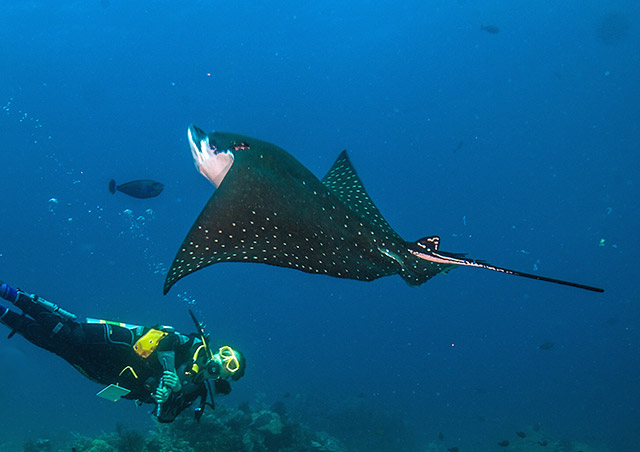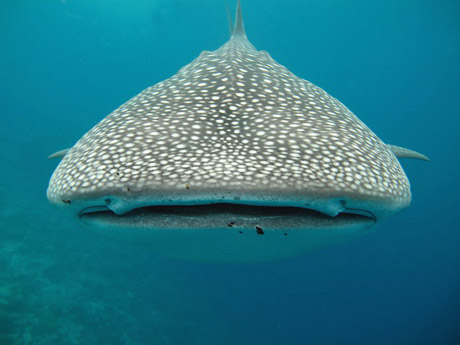SCUBA News~~~~~~~~~~~~~~~~~~~~~~~~~~~~~ Welcome to the 300th issue of SCUBA News! We're the longest running scuba diving e-newsletter in the world! (Well, that's according to ChatGPT anyway.)
Celebrating 25 years of SCUBA NewsWe've been publishing SCUBA News (ISSN 1476-8011) for 25 years, and much has changed in that time. First issue was entirely text - with links to images on the web but not in the newsletter itself. Those were the days of dial-up connections, when downloading emails meant that the phone was busy so the shorter download time the better for many people. Here's what it looked like.
Refreshingly short, you can read it at https://www.scubatravel.co.uk/scubanews1.html. Over time SCUBA News has evolved. We added the diving news from around the world to our second issue, which is still a feature today. The first Creature of the Month arrived in issue 34 - the beautiful Jewel Anemone. We finally added colour photos in Issue 80, mostly taken by Tim Nicholson (thank you Tim). We still review books, and have helped several of our readers get in touch with the authors. We used to get many emails from readers, not so many now - but we always enjoy hearing from you so please get in touch with your stories, reviews, questions and comments. What's changed in diving over 25 years? A lot. It is so much easier to take underwater photos, when we started underwater cameras were much more expensive than now and GoPros hadn't been invented. But the sea has suffered in the intervening years. Climate change has badly affected coral reefs, and many species of fish have become much scarcer due to overfishing, warming seas, pollution and generally actions by humans. On the plus side, divers are aware of the problems and many of us are now actively engaged in conservation measures. Over the last 25 years, we've had many divers write articles for us. A big thank you to: Bill Mashek, Tab Hauser, Kathryn Curzon, Alan Gurevich, Jill Heinerth, Nirupam Nigam, Sam Andrews, Samantha Craven, Stephen Rogers, Jake Mojiwat, Joanne Swann, Gaye Rosier and all our other contributors. If you want to share an article, review some dive gear, tell us about your latest diving trip - please do! But, of course, the most important people are you, the readers. So thank you so much! We'd love to find our longest subscribing reader - let us know when you first received SCUBA News. And don't forget to enter our 300th celebratory competition to win diving film festival tickets. Here's to another 25 years of diving passion, discovery and community. Free Draw for Diving Film Festival TicketsWe're delighted, in this 300th issue, to offer subscribers a chance to win free tickets to the Ocean Film Festival. Just email us with the dates and location that you would like to attend. More details are at https://www.news.scubatravel.co.uk/
Liveaboard Diving Offers: Dive for LessGet up to 50% off at some of the best diving spots in the world.
Creature of the Month: The Spotted Eagle RayThe spotted eagle ray (Aetobatus ocellatus) is a vital part of coastal marine ecosystems throughout the Indo-Pacific. Elsewhere it is replaced by A. narinari, also called the spotted eagle ray and with very similar lifestyle.  How to spot themOnce seen easily recognised. They are large and can be 3 m across. They live on seagrass flats and sandy areas of coral reefs. Eagle Rays are more often seen actively swimming than other rays. You might see them flying through the ocean, flapping their pectoral fins like birds wings. They are often encountered near the surface and sometimes even jump out of the water. Normally they are solitary but sometimes congregate in large groups.  Bottom feedersSpotted eagle rays, unlike filter-feeding manta rays, forage along the soft seabed. With mouths positioned on their undersides, they are perfectly adapted to uncovering prey buried in the sand: gastropods, bivalves, crustaceans, worms, octopuses and small fish. As they grow older they tend to eat more fish and cephalopods.  Bursts of Speed for rapid escapes, but at a costWhen faced with a predator, eagle rays employ a rapid escape response, speeding away. But, this energetic burst comes with a cost, necessitating recovery periods where they rest on the bottom for extended periods. The noise of motor boats also frightens foraging rays, causing them to flee the area. This not only interrupts their feeding, but again they need to rest. Why such long tails?The long, slender tail of the spotted eagle ray can be up to 4.6 times its body length. Experimental evidence suggests that a tail 0.9x body length greatly enhances stability during gliding, but there is no movement advantage with longer tails. Research by Julia Chaumel and colleagues suggests that the tail helps detect predators. It contains an extensive lateral line system that allows the ray to detect sudden water movements, prompting it to shoot off and escape. Furthermore, in captivity, observations suggest the tail may be used in the formation of large schools, with individuals maintaining physical contact with the tail of the ray in front.  You might notice in the photos that some of the rays have quite short tails. This will be due to injury where their tail has been damaged. Long pregnancy: few pupsA female eagle ray's pregnancy lasts a year. She then gives birth to up to four fully developed pups, measuring 17-35 cm across. Young Eagle Rays are kept in nurseries: a place where the mother gives birth and the babies and juveniles spend the first part of their lives. It's thought that nursery grounds provide the young a better source of food and protection against predation Declining by up to 79% over 39 yearsDespite their widespread distribution, the Spotted Eagle Ray endures many threats across much of its range. Unfortunately, the same shallow, inshore habitats that provide food and shelter also make it highly susceptible to human impacts: habitat loss, environmental degradation and unregulated fisheries. In regions like Borneo and the Western Indian Ocean, fishing pressure is intense and often unmanaged. These threats, coupled with its slow reproductive rate, have led to alarming population declines. Recent IUCN Red List assessments have uplisted A. ocellatus to Endangered, inferring a population reduction of 50-79% over the last three generations (39 years) across much of its range.  What can be done?Conservation measures for the Spotted Eagle Ray are currently scarce. Australia is the exception. There they have mandated bycatch reduction devices in trawl fisheries which has reduced eagle ray catches by up to 90%! The overall picture for the Spotted Eagle Ray highlights the need for stricter fishery management and habitat protection across its extensive, yet increasingly vulnerable, Indo-Pacific domain. Class: Chondrichthyes > Order: Myliobatiformes > Family: Aetobatidae > Genus: Aetobatus > Species: Aetobatus ocellatus ReferencesAraujo G et al (2024) Citizen science highlights rare behaviours by the spotted eagle ray Aetobatus ocellatus Kuhl 1823. Front. Mar. Sci. 11:1406803. doi: 10.3389/fmars.2024.1406803 Finucci B et al (2024). Aetobatus ocellatus. IUCN Red List Threatened Species 2024. Cecile Berthe, David Lecchini (2016) Influence of boat noises on escape behaviour of white-spotted eagle ray Aetobatus ocellatus at Moorea Island (French Polynesia). C. R. Biol. Vol 339, Issue 2. https://doi.org/10.1016/j.crvi.2016.01.001 Julia Chaumel et al (2025) The tail of myliobatid rays controls body stability bioRxiv 2025.04.30.651532; doi: https://doi.org/10.1101/2025.04.30.651532 Diving news from around the World
| ||||||||||||||||||||||
| SCUBA News is licensed under a Creative Commons Attribution 4.0 Unported License. This means we are happy for you to reuse our material for both commercial and non-commercial use as long as you: credit the name of the author, link back to the SCUBA Travel website and say if you have made any changes. Most photos though, are copyright the photographer. Please get in touch for details. Photo credits: Tim Nicholson, Jill Studholme, ProtectedSeas, Rocco Canella, Benjamin-I Jones, Andrea Izzotti/DepositPhotos, divebooker.com UNSUBSCRIBING ADVERTISING CONTACTING THE EDITOR |
Sunday, July 27, 2025
SCUBA News turns 25 - the 300th Issue 🎈✨🎉
Subscribe to:
Post Comments (Atom)



















No comments:
Post a Comment